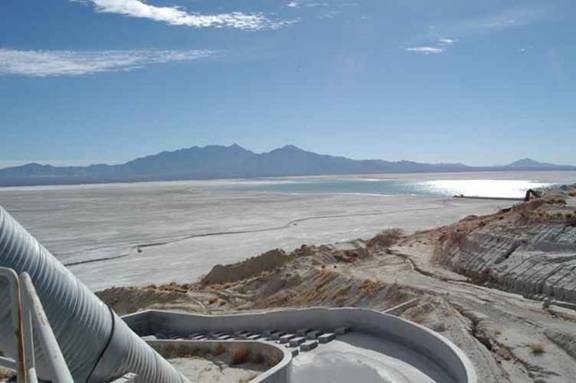Environmental Impact of Flotation Processing
Valuable minerals in an ore can be separated from each other, and from worthless minerals, by the froth flotation process. The need for a process to extract ore arose from major sulfide mineralization after the oxide ores had been depleted.
The technology involves first crushing the ore, typically to a particle size of about 5 to 50 micrometers, to liberate separate grains of the various valuable minerals and worthless components. Then the particles are pulped with water, and the surface of the mineral of interest selectively made hydrophobic "having little or no affinity for water” through the addition of an organic species, which is termed a collector. Following this procedure, a stream of air bubbles is passed through the pulp; the bubbles attach to the hydrophobic particles, which collect in a froth layer. A frother, such as a long chain alkyl alcohol, is added to create a stable froth layer in the cell.
The collectors are various chemicals of hydrocarbons with complex configurations, yet some are as simple as kerosene. It is claimed that the volatile organics used in the Flotation Process do not go into the slurry that goes into the tailings impoundment because they are filtered out before the slurry goes to the impoundment. This is not a sound analysis.
1) Filtration is not a treatment technology for volatile organics. Treatment is pushing air the solution which releases the volatile chemicals into the air [Bless the employees who endure this process—it would definitely fall under OSHA regulations].
2) Some are amine compounds that break down into nitrates, so the presence of nitrates in the groundwater is an indicator of travel of these compounds, which can be very mobile in an oxygen solution (H 2O).
Some of the Chemicals Used in Flotation Process:
Alky Aryl Oxime
Petroleum Distillate
Sulfosuccinate surfactant
Alkyl xanthate salt
Nalco 7873—no chemical formula given
Alcohol/hydrocarbon blend
The slurry with waste minerals and residues of chemicals are sent by pipeline to tailings impoundments, while the valuable metals that have been floated out are sent to a smelter to be purified.
Tailing Impoundments
The impoundments that hold the slurry or “tailings” can be gigantic. The tailing impoundment dam at the Phelps Dodge Ajo operations was listed as the world’s biggest Guinness Book of Records

3,600 acre tailing impoundment, Green Valley, AZ
Date |
Hardness as CaCO 3 |
Calcium mg/l |
Magnesium mg/l |
Sulfate |
Arsenic mg/l |
TDS |
pH Units |
12/17/79 |
|
631 |
<1 |
1,806 |
|
2,856 |
9.2 |
12/02/80 |
|
608 |
5 |
1,842 |
|
2,885 |
9.4 |
11/23/81 |
|
601 |
7 |
1,948 |
|
3,011 |
9.3 |
|
|
|
|
|
|
|
|
11/02/88 |
|
640 |
.08 |
1,720 |
|
3,280 |
10.9 |
1989 |
|
655 |
.63 |
1,910 |
ND |
3,300 |
10.27 |
Typical composition of Tailing Impoundment
Tailing Dam Failures
Dam failures occur all over the world, in 1980 at the Phelps Dodge copper operations in Tyrone, New Mexico, there was a major failure of a tailings impoundment dam. When the dam ruptured, there was such a flood of water that power lines were knocked over, water mains were broken. "Fortunately, a series of check dams along the dry streambed contained the mess, and there were no personal injuries."
There was a particularly fateful one in New Mexico. The biggest expulsion of radioactive material in the United States occurred July 16, 1979, at 5 a.m. on the Navajo Nation, less than 12 hours after President Carter had proposed plans to use more nuclear power and fossil fuels. On that morning, more than 1,100 tons of uranium mining tailings gushed through a packed-mud dam near Church Rock, N.M. With the tailings, 100 million gallons of radioactive water gushed through the dam before the crack was repaired.
By 8 a.m., radioactivity was monitored in Gallup, N.M., nearly 50 miles away. The contaminated river, the Rio Puerco, showed 7,000 times the allowable standard of radioactivity for drinking water below the broken dam shortly after the breach was repaired, according to the Nuclear Regulatory Commission. The few newspaper stories about the spill outside of the immediate area noted that the area was "sparsely populated" and that the spill "poses no immediate health hazard."
Smelters
Air Quality : The residue copper sulfide concentrates is smelted at high temperature, in which process the sulfur in the metal sulfide is oxidized with air or oxygen to sulfur dioxide, and molten metal is produced. The sulfur dioxide needs to be captured for air-quality reasons and is converted into sulfuric acid. Depending on the trace metals in the ore the particulate can contain more serious contaminants, such as lead and arsenic. The dust can settle and therefore contaminate soil and/or surface water. With time, the contaminants can enter groundwater. Smelters have scrubbers that must be maintained properly to keep the emissions at an acceptable level.
Slag piles: Toxic metals can also be present in the waste slag piles. These metals can leach down into the soil, groundwater and run-off the site to contaminate other areas.

The Black Spot—larger than several city blocks ― on this Google Earth map of Superior is the Slag Pile from the past Magma mining operations